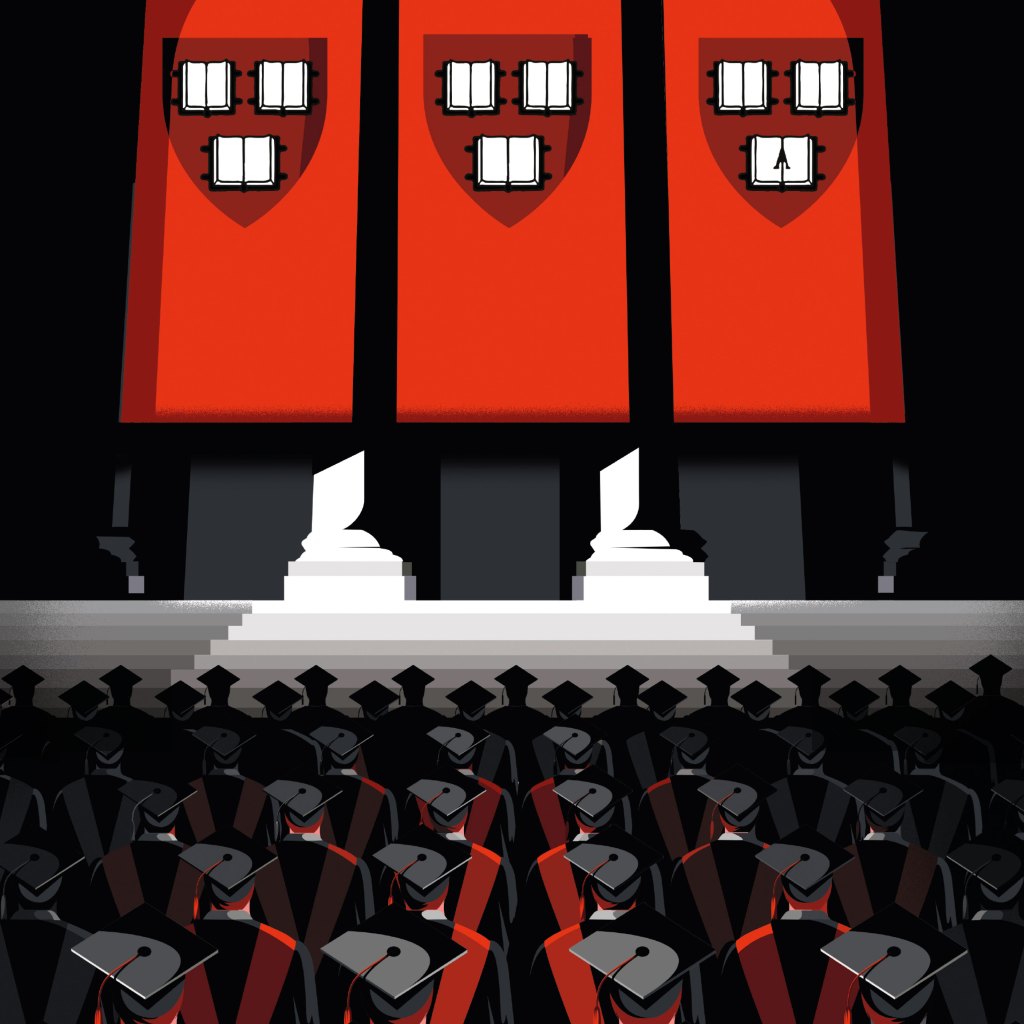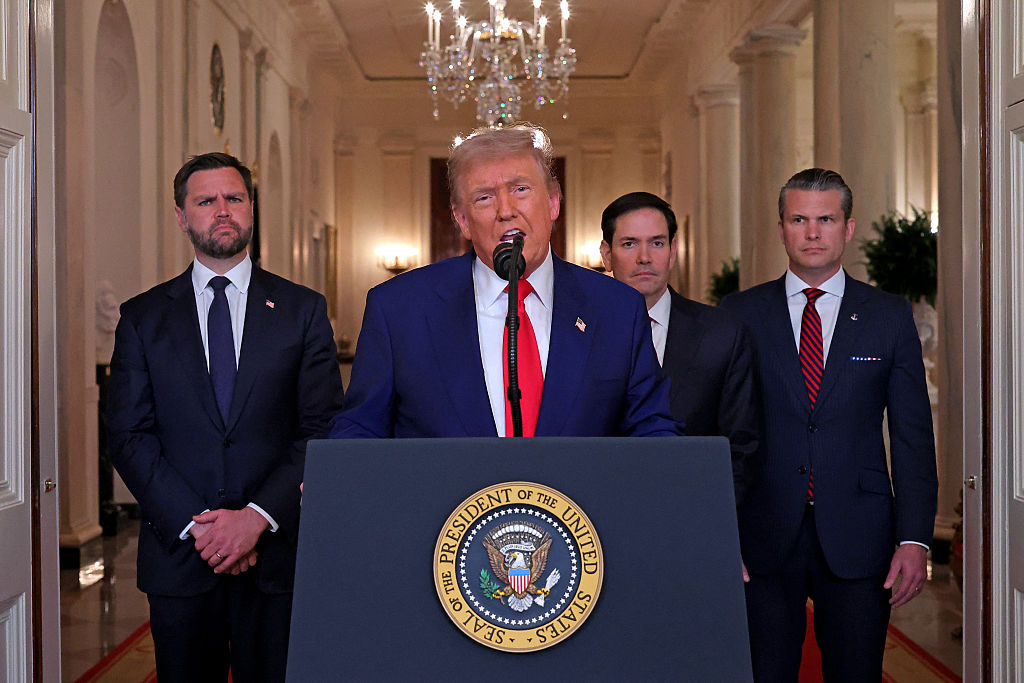In the aftermath of the October 7 attack on Israel, when videos were circulating on social media showing the enormities perpetrated on Israelis by Hamas terrorists — women raped, old people and children abducted, civilians murdered en masse — students of Harvard’s leftist groups banded together to condemn… Israel. Members of thirty-four student organizations signed a letter declaring that they “hold the Israeli regime entirely responsible for all unfolding violence.” The spectacle of America’s elite youth engaging in a shameless act of victim-blaming sent shockwaves through the world.
Reprehensible as the letter is, the reality is that Harvard’s relentless pursuit of elitism has, for generations, been a breeding ground for antisemitism. The reason is simple: Harvard levers itself up by pushing down on the scorned, despised or otherwise marginalized other. And there are few others as scorned, despised and marginalized as Jews.
To say Harvard is the world’s most powerful engine of elitism is almost an understatement. Eight presidents, including JFK, both Roosevelts, Obama and George W. Bush were Harvard grads. George Washington was the recipient of its law school’s first degree (honorarily). No fewer than nine signers of the Declaration of Independence were Harvard graduates, including the man whose name has become synonymous with the very concept of a signature, John Hancock. In 2017, six Supreme Court justices, all graduates of Harvard Law, gathered to fête their alma mater, which isn’t so surprising considering no fewer than twenty-four of the court’s 115 total justices have been Harvard graduates.
“Want your kid to become one of the richest people in the world? Send them to Harvard,” advises Forbes, the magazine famous for its list of the world’s richest people. They weren’t exaggerating: Bill Gates, Mark Zuckerberg, Jamie Dimon, Bill Ackman, Meg Whitman, Ray Dalio, Charlie Munger, Paul Graham, Henry Paulson and Sheryl Sandberg (to take a tiny sampling) all attended. With a $53 billion endowment, Harvard is the world’s richest university, boasting nearly $10 billion more under management than Yale, its next largest competitor. In the 2021 fiscal year alone, the endowment generated $11 billion in gains. (And because the money is tucked into a university endowment, all those billions are blissfully tax-free.) “Harvard is blessed with the broadest and deepest assembly of intellectual talent and academic resources in the world, and it is to Harvard that the whole world looks for leadership,” said Rick Levin, the president of chief rival Yale.
What’s interesting about the present moment, however, is that the elitism that has spread at Harvard is an expression of the racial hierarchy that has existed at the university since the seventeenth century. Over the past decade, this racial hierarchy began to emerge at elite American institutions resulting in thought leaders like Ibram X. Kendi openly pushing for a new form of racial discrimination that privileges people of color in the name of equity. Many of these ideas swirling around the new race pyramid can be traced back to Harvard. It was there that Derrick Bell, Harvard Law School’s first black professor, introduced theories that would later come to be known as Critical Race Theory, arguing that anti-black racism is a permanent and ineradicable feature of American life, the “original sin” that Nikole Hannah-Jones wrote about in the lead essay for the New York Times’s 1619 Project. It was at Harvard where Kimberlé Crenshaw developed theories on “intersectionality” that led to the strange sight of LGBTQ “Queers for Palestine” activists marching not merely for the Palestinians but specifically against Israel and its very right to exist. And it was at Harvard’s Divinity School that Cornel West built a liberation theology that stands in large part on an anti-Israel plank and whose rhetoric veers into antisemitism — including the unsupported claim that his denial of tenure by Harvard was caused by a Zionist plot to exact retribution against him.
The history of Harvard teaches us that these elite must define itself against a morally, intellectually or socially lesser other. Today, among those others are the Jews, who have been defined by the post-colonialist and social justice movements as nothing less than the enforcers and enablers of white supremacy. This effort to anchor anti-Jewish sentiment in post-colonial theory has paid rich dividends. It’s allowed parts of the Harvard community to conduct a broad attack on the university’s Jewish population, though it’s cloaked in discourse about occupation, imperialism and the efforts of the Boycott Divestment Sanctions campaign.
It’s still considered rather bad form to be openly anti-Jew (or it was until recently) so “Jews” has been swapped out for “Israelis,” who are openly vilified by Harvard’s new elite. Harvard undergrad Sabrina Goldfischer spent a year writing her senior thesis on anti-Jewish activity at Harvard, including by interviewing sixty Jewish students. Her findings were shocking, but not surprising. “Social alienation is unavoidable for Harvard’s Israeli students,” Goldfischer wrote in a Times of Israel post last April. “Students recall moments of feeling like their ‘humanity was questioned.’ One student said to their Israeli peer, ‘I can only imagine the war crimes you have committed.’ Another explained that his friend was not allowed into a social organization when the leadership discovered he was Israeli.”
Things have only gotten worse; the most brazen expression of antisemitism at the university came on the heels of a massacre of Jews in Israel, a horrific echo of what took place around the world as Nazism rose nearly a century ago. Both Hamas and Nazis hold extremist ideologies driven by a metaphysics inseparable from the aim of Jewish genocide. And despite the nine-decade gulf, both were at various times embraced by Harvard to a disturbing degree.
While much has been made of the admissions quotas to which Harvard’s Jewish students were subject in the early twentieth century, the quotas obscure the extent to which antisemitism runs in the university’s roots. In the early 1930s, when Harvard’s outgoing president Abbott Lowell — who transformed the elite regional college into a national powerhouse — handed over the reins to his successor, James Conant, he issued a stark warning: “Any educational institution that admits an unlimited number of Jews will soon have no one else.”
Far from the attitude of a single administrator, this was a belief that had been institutionalized at Harvard. For years, Jews were assigned an asterisk next to their names on the university’s housing register to indicate “a racial group for which the supply exceeds the House Masters’ demand,” as one Harvard official slyly put it. Jewish students knew not to even attempt to climb Harvard’s sacred social structure by joining its famous “finals clubs” (the Harvard equivalent of a fraternity).
In 1934, at a moment when the Nazi monster had taken firm root in Germany, Harvard rolled out the red carpet for Ernst “Putzi” Hanfstaengl, a close friend of Hitler’s who took credit for creating the Nazi salute and Sieg Heil chant, both of which (he boasted) drew on his experience as a Harvard football cheerleader. Two years later, the University of Heidelberg, then “thoroughly Nazified,” invited Harvard to send a delegation to celebrate its 550th anniversary. Harvard agreed, breaking a boycott of the proceedings by Yale, Princeton, Oxford and Cambridge. The university sent its dean of faculty, who attended the ceremony alongside Hanfstaengl, German science minister Bernhard Rust, Nazi racial theorist Alfred Rosenberg, Joseph Goebbels and Heinrich Himmler. The Harvard dean’s main reflection on the ceremony consisted of praise — “Joseph Goebbels ‘spoke briefly and gracefully and appropriately,’” according to the book Making Harvard Modern.
When Conant was asked to sign a letter of protest along with the presidents of Columbia and Yale to be addressed to the University of Heidelberg concerning its Nazi activities, he initially agreed. But at the last minute, Conant refused to sign, saying that nothing Goebbels or Himmler had said at the event “justified the publication of the joint statement.”
The reality was that Conant’s actions were in keeping with what, by then, had become a Harvard tradition. Conant’s predecessor, Lowell, had refused to sign a letter condemning the Nazis’ anti-Jewish policies, despite the fact that a hundred presidents of top US colleges had done so. While universities around the country opened their doors to Jewish refugee scholars from Europe, Harvard refused. “He is a Jew I believe… but isn’t an objectionable one,” Conant wrote about a Jewish refugee from Nazi Germany seeking a position at the school. For Conant the question was representative of a bigger problem presented by Jewish academics fleeing Europe — a problem tied to the core of Harvard’s elitism. “I think a deluge of medium and good men of the Jewish race in scientific positions… would do a lot of harm,” Conant, a distinguished chemist, wrote in a letter to a colleague on the question. “Needless to say, don’t quote me too widely on any of this.”
The roots of this attitude might be traced back to the central role the university played in eugenics, with one scholar characterizing Harvard as “the brain trust of the eugenics movement.” A constellation of leading Harvard figures took up the mantle, including Charles Eliot, a revered university president from 1869 to 1909. Elliot championed eugenics as a means of achieving racial purity: “Each nation should keep its stock pure,” Eliot once told an audience. “There should be no blending of races.”
The pro-eugenics movement at Harvard also included Lowell and the famous American jurist Oliver Wendell Holmes. Backed by his Brahmin belief in bloodlines, Holmes spearheaded the Supreme Court decision in Buck v. Bell that cleared the way for eugenics-based forced sterilization of undesirables and the “feeble-minded” (which in that particular case referred to a woman who became pregnant out of wedlock).
Concepts of pure racial bloodlines were bound up with Harvard’s elitism — eugenics’ proponents thought it could produce a stock of superior men, of enhanced intellectual ability and moral character. In addition to the Jews, that naturally made other races undesirable. Harvard often bragged that it had no anti-black policy, but the reality was quite different — blacks were mostly kept out of the university by intolerably high fees that they could not afford. Nevertheless, when the mother of a liberal Harvard student killed in World War Two asked to establish a scholarship for black students she was denied, again by the progressive-minded Conant, who, at the time, was busy preaching the gospel of meritocracy in the pages of the Atlantic. Similarly, when, in 1935, a university professor asked Conant if he could bring Alain Locke, the visionary black intellectual behind the Harlem Renaissance — and a Harvard PhD and Rhodes Scholar at that — for a visiting lectureship, Conant refused, saying he could not see how Locke could be invited “even for a few lectures.”
More recently, Harvard’s engine of elitism turned to other groups of undesirables against which it could define itself. Asian Americans have suffered what amounts to a system of discrimination that Harvard has not attempted to hide, instead fighting for it all the way to the Supreme Court. And while Jews and blacks were, historically, heavily discriminated against, they were at least allowed on campus. Not so with women. Despite the “separate but equal” system of the Harvard-Radcliffe system by which men were admitted to Harvard and women to Radcliffe, the truth is that for decades Harvard forbade women from entering some of its buildings. It took until 1967, three years after the US passed the Civil Rights Act, for women to be allowed to physically step foot into Lamont Library.
This had profound implications not in the abstract but for real people. In 1944, Pauli Murray, a brilliant black female graduate of Howard Law School and civil rights activist, applied to study with Harvard constitutional lawyer Thomas Reed Powell. Her application was seriously considered — Powell realized that Pauli was black, but hadn’t caught on that she was a woman: “I assumed that you were a member of the sex entitled to be a student at Harvard Law School,” Powell wrote concerning Murray’s rejection. Murray enlisted the help of none other than FDR, who wrote to Conant — to no avail.
These are far from relics of past transgressions. In 2022, three female graduate students filed a lawsuit against the university, alleging they had been sexually harassed and assaulted by a celebrated professor of African anthropology who, in one instance, smirkingly told a gay student that in parts of Africa she would be subject to “corrective rape.” More than three dozen Harvard academics signed an open letter in defense of the professor, including liberal icons like Henry Louis Gates Jr., a campaigner for racial equality, and Jill Lepore, noted for her contributions to feminist thought. (The letter was retracted following an uproar.)
Today, the university is facing a similar uproar over yet another letter. This time, the letter was issued not in support of a single professor amid allegations of misconduct, but against the victims of mass rape, murder and kidnapping. And while the 2022 letter was signed by professors, the traditional backbone of the university’s power structure, today it’s the bottom-up power base of the student body that has committed what can only be described as a moral offense.
Over the past decades, the academy has been at the fore of the idea that ideas and views can constitute a unique, and literal, form of violence. With the university students’ defense of Hamas, we’ve seen another flip: literal violence — a pogrom — has been claimed as a morally positive act. Where Harvardians preached “silence is violence” in the context of the violation of black and brown bodies, where Jews are concerned violence is reduced linguistically to “resistance.”
Here are the students of the world’s most elite institution claiming for themselves the most elite status of all: victimhood.
As students wrote in a follow-up letter to university leadership, “the administration’s refusal to actively protect the free speech of Palestinian, Arab, black and Muslim students has had a chilling and dangerous effect across campus.” For Jews, who had just witnessed a slaughter of innocents in Israel, the message is unmistakable: keep your mouths shut. Know your place. Stay in your lane.
This article was originally published in The Spectator’s December 2023 World edition.























Leave a Reply